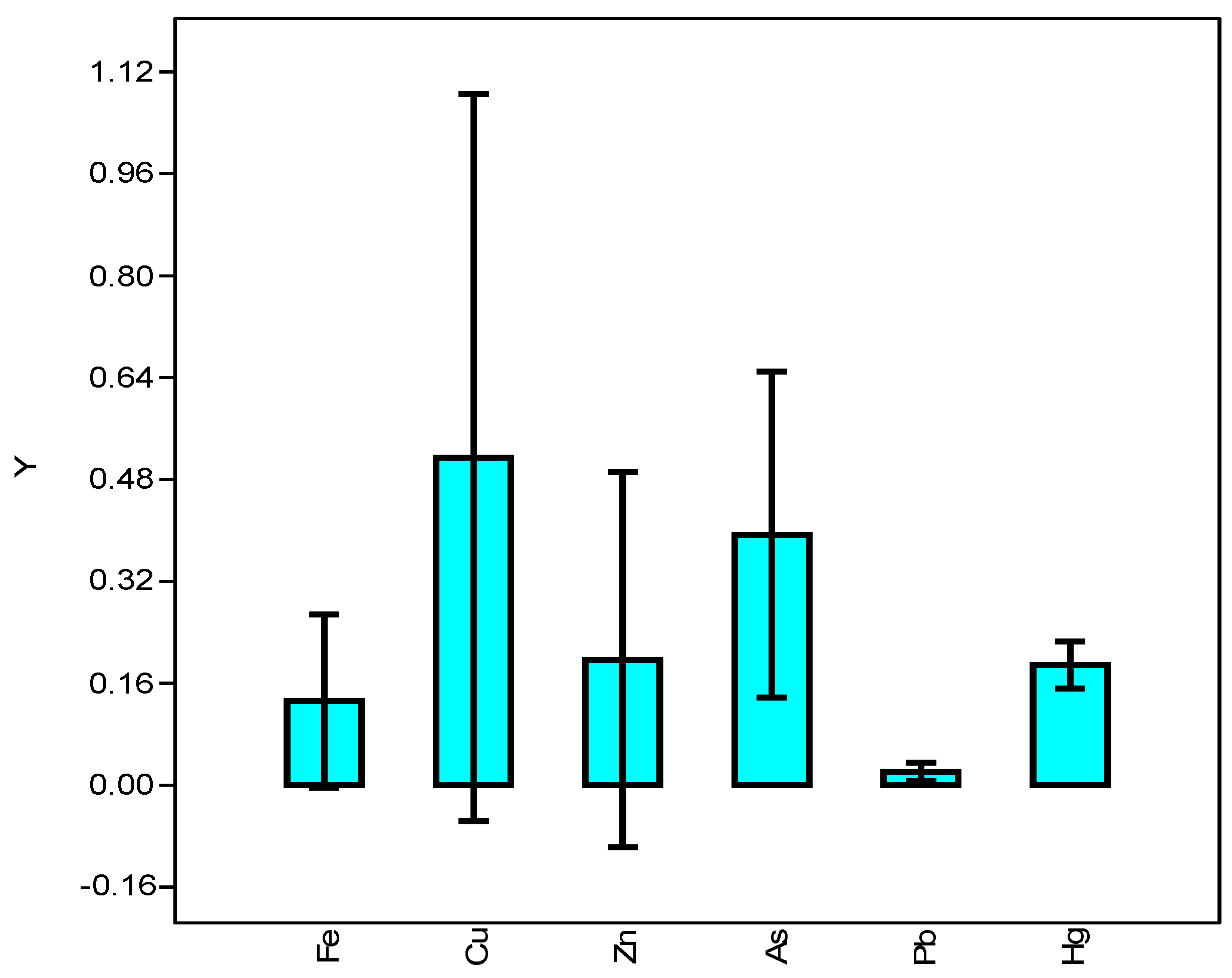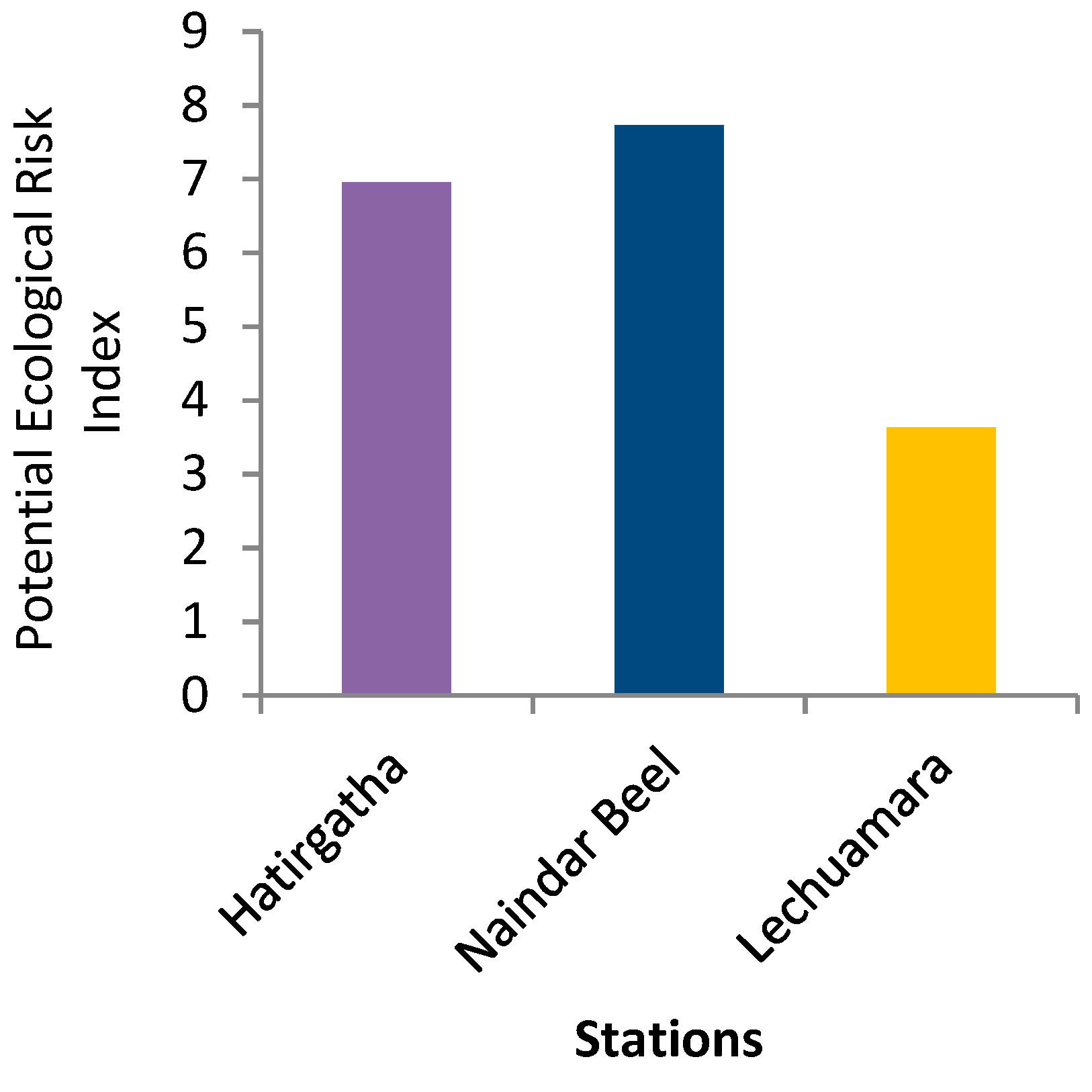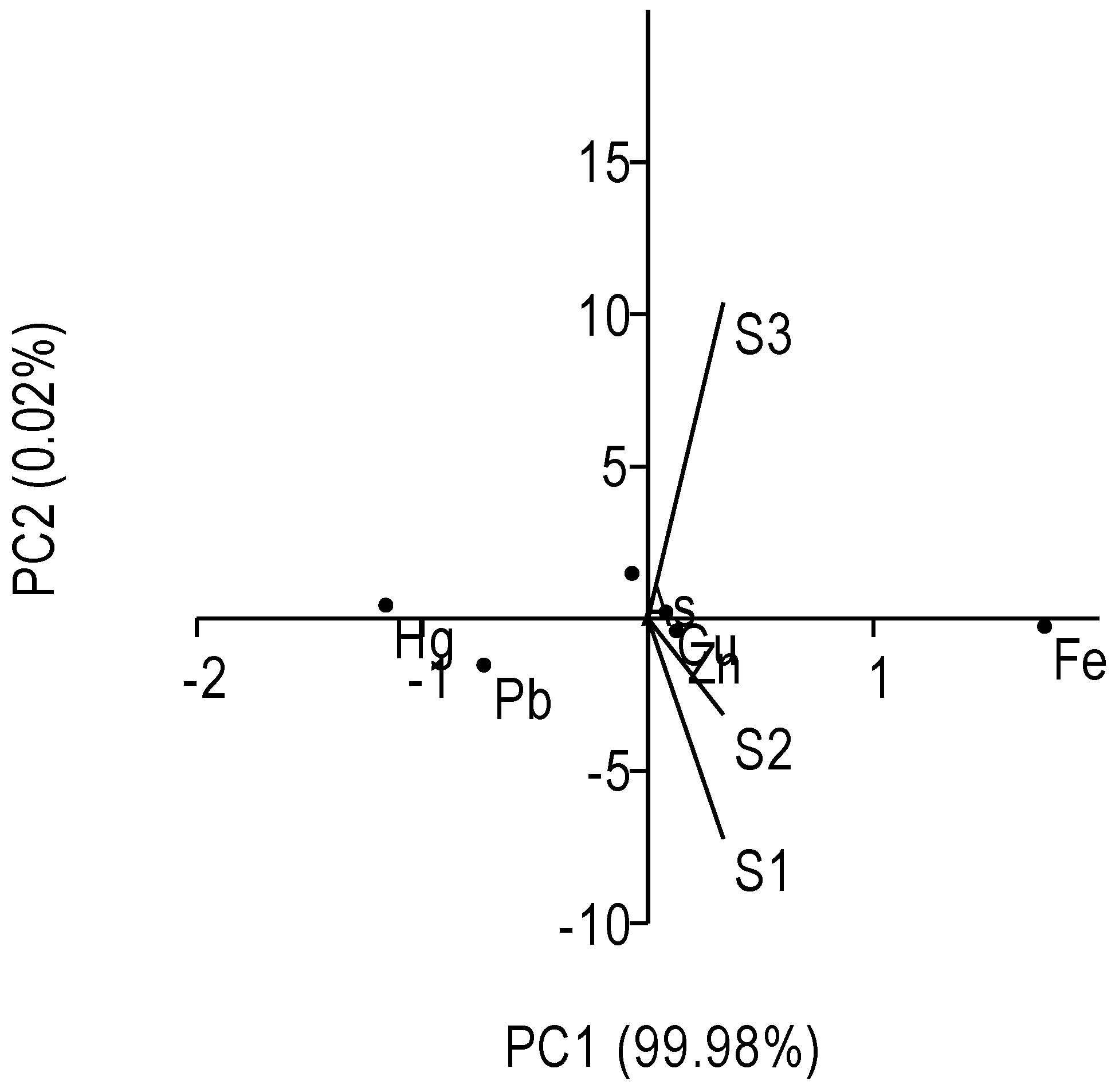Contamination and Ecological Risk Evaluation of Metals in Sediments from a Wetland of International Importance (Ramsar Site)
Abstract
:1. Introduction
2. Materials and Methods
2.1. Study Area Description
2.2. Selection of Study Site and Period
2.3. Sample Collection and Preparation
2.4. Contamination Indices for Sediment
2.5. Potential Ecological Risk Assessment
2.6. Statistical Analysis
3. Results and Discussion
3.1. Metal Concentrations in Sediment of Tanguar Haor
3.2. Contamination Levels Assesemnt of Metals in Sediments
3.3. Potential Ecological Risk Assessment (PERI)
3.4. Source Identification of Heavy Metals Using Univariate and Multivariate Analyses
3.5. Limitations of the Study
3.6. Current Challenges and Future Perspectives
4. Conclusions
Author Contributions
Funding
Institutional Review Board Statement
Informed Consent Statement
Data Availability Statement
Acknowledgments
Conflicts of Interest
References
- Hu, S.; Niu, Z.; Chen, Y.; Li, L.; Zhang, H. Global wetlands: Potential distribution, wetland loss, and status. Sci. Total Environ. 2017, 586, 319–327. [Google Scholar] [CrossRef] [PubMed]
- Wantzen, K.M.; Alves, C.B.M.; Badiane, S.D.; Bala, R.; Blettler, M.; Callisto, M.; Zingraff-Hamed, A. Urban stream and wetland restoration in the Global South—A DPSIR analysis. Sustainability 2019, 11, 4975. [Google Scholar] [CrossRef]
- Shen, X.; Liu, B.; Jiang, M.; Lu, X. Marshland loss warms local land surface temperature in China. Geophys. Res. Lett. 2020, 47, e2020GL087648. [Google Scholar] [CrossRef]
- Shen, X.; Jiang, M.; Lu, X.; Liu, X.; Liu, B.; Zhang, J.; Wang, Z. Aboveground biomass and its spatial distribution pattern of herbaceous marsh vegetation in China. Sci. China Earth Sci. 2021, 64, 1115–1125. [Google Scholar] [CrossRef]
- Fluet-Chouinard, E.; Stocker, B.D.; Zhang, Z.; Malhotra, A.; Melton, J.R.; Poulter, B.; McIntyre, P.B. Extensive global wetland loss over the past three centuries. Nature 2023, 614, 281–286. [Google Scholar] [CrossRef]
- Costanza, R.; Anderson, S.J.; Sutton, P.; Mulder, K.; Mulder, O.; Kubiszewski, I.; Dee, G. The global value of coastal wetlands for storm protection. Glob. Environ. Change 2021, 70, 102328. [Google Scholar] [CrossRef]
- Alam, A.B.M.S.; Badhon, M.K.; Sarker, M.W. Biodiversity of Tanguar Haor: A Ramsar Site of Bangladesh Volume III: Fish; IUCN, International Union for Conservation of Nature, Bangladesh Country Office: Dhaka, Bangladesh, 2015; p. xii+216. [Google Scholar]
- GoB (Government of Bangladesh). Tanguar Haor Wetland. Biodiversity Conservation Project; Ministry of Environment and Forest, Goverment of the People’s Republic of Bangladesh: Dhaka, Bangladesh, 2004; p. 73.
- Sun, C.; Zhen, L.; Miah, M.G. Comparison of the ecosystem services provided by China’s Poyang Lake wetland and Bangladesh’s Tanguar Haor wetland. Ecosyst. Serv. 2017, 26, 411–421. [Google Scholar] [CrossRef]
- Pradit, S.; Noppradit, P.; Jitkaew, P.; Sengloyluan, K.; Kobkeatthawin, T.; Laerosa, A.; Sirivithayapakorn, S. Heavy Metal Contamination and Ecological Risk Assessment in the Sediment Cores of the Wetlands in Southern Thailand. J. Mar. Sci. Eng. 2022, 10, 1921. [Google Scholar] [CrossRef]
- Singh, J.; Sharma, P.; Mishra, V. Simultaneous removal of copper, nickel and zinc ions from aqueous phase by using mould. Int. J. Environ. Sci. Technol. 2023, 20, 1937–1950. [Google Scholar] [CrossRef]
- Kljaković-Gašpić, Z.; Herceg-Romanić, S.; Kožul, D.; Veža, J. Biomonitoring of organochlorine compounds and trace metals along the Eastern Adriatic coast (Croatia) using Mytilus galloprovincialis. Mar. Pollut. Bull. 2010, 60, 1879–1889. [Google Scholar] [CrossRef]
- Türkmen, A.; Türkmen, M.; Tepe, Y.; Akyurt, I. Heavy metals in three commercially valuable fish species from Iskenderun Bay, Northern East Mediterranean Sea, Turkey. Food Chem. 2005, 91, 167–172. [Google Scholar] [CrossRef]
- Hossain, M.S.; Nayeem, A.; Majumder, A.K. Impact of flash flood on agriculture land in Tanguar Haor Basin. Int. J. Res. Environ. Sci. 2017, 3, 42–45. [Google Scholar]
- Bhuiyan, M.A.; Asaduzzaman, K.; Kowser, A.; Islam, S.; Islam, M.; Kakoly, S.; Khondker, M. Natural Radioactivity Levels and Radiological Risk Assessment of Surface Water of Wetland Tanguar Haor, Sunamganj District, Bangladesh. Bangladesh J. Rad. Nucl. Appl. 2019, 4, 117–125. [Google Scholar]
- Bhuiyan, M.A.H.; Kowser, A.; Islam, S.A.M.S.; Mohid, M.; Islam, M.R.; Kakoly, S.A.; Khondker, M. Phytoplankton flora of Tanguar Haor Ecosystem of Bangladesh: Chlorophyta. J. Biodivers. Conserv. Bioresour. Manag. 2019, 5, 101–106. [Google Scholar] [CrossRef]
- Hossain, M.S.; Islam, M.S.; Mondal, P.; Hoq, M.E. Assessment of aquatic natural resources in the Tanguarhaor at Sunamgonj, Bangladesh. Bangladesh J. Fish. Res. 2012, 15, 81–92. [Google Scholar]
- Hussain, M.G. Biological Diversity Status of Fish Genetic Resources at Tanguar Haor Wetland in Bangladesh. Bangladesh Marit. J. 2021, 5, 193–206. [Google Scholar]
- Ara, D.; Islam, S.M.Z. Role of Stakeholders in Preserving Biodiversity in Bangladesh: A Study on Tanguar Haor. Int. J. Manag. 2019, 10, 17–38. [Google Scholar] [CrossRef] [PubMed]
- Khan, M.M.H.; Khan, T.A.N.I.A.; Ahmed, A.; Shovon, T.A. Notes on nesting Bristled Grassbird Chaetornis striata, Tanguar Haor, Bangladesh. Bird. ASIA 2015, 24, 93–95. [Google Scholar]
- Solayman, H.M.; Baten, M.A.; Khan, M.B. Status and economic valuation of ecosystem services of Tanguar haor: A wetland of Bangladesh. J. Bangladesh Agric. Univ. 2018, 16, 237–243. [Google Scholar] [CrossRef]
- Hasan, A.M.; Awoal, R.; Sumon, T.A.; Alal, M.; Hossen, T.A.; Chowdhury, M.A.; Uddin, M.S. Species diversity and seasonal composition of aquatic weeds in Tanguar haor area at Taherpur upazilla under Sunamganj district, Bangladesh. Int. J. Fish. Aquat. Stud. 2018, 6, 570–574. [Google Scholar]
- IUCN (International Union for Conservation of Nature). Tanguar Haor Management Plan Framework and Guidelines; IUCN Bangladesh Country Office: Dhaka, Bangladesh, 2015; p. xiv+202. [Google Scholar]
- Sobhan, I.; Alam, A.B.M.S.; Chowdhury, M.S.M. Biodiversity of Tanguar Haor: A Ramsar Site of Bangladesh, Vol. 2: Flora; IUCN Bangladesh: Dhaka, Bangladesh, 2012; p. xii+236. [Google Scholar]
- Chowdhury, A.H. The state of Community based Sustainable Management of Tanguar Haor. In Proceedings of the 16th Annual International Sustainable Development Research Conference, The Kadoorie Institute, University of Hong Kong, Hong Kong, 30 May–1 June 2010; Available online: http://www.kadinst.hku.hk/sdconf10/Papers_PDF/p35.pdf (accessed on 23 April 2022).
- IUCN (International Union for Conservation of Nature). Disaster Risk Reduction (DRR) on Tanguar Haor; IUCN Country Office: Dhaka, Bangladesh, 2010; p. 35. [Google Scholar]
- Rahaman, M.M.; Sajib, K.I.; Alam, I. Impacts of climate change on the livelihoods of the people in Tanguar Haor, Bangladesh. J Water Resour. Eng. Manag. 2016, 3, 1–9. [Google Scholar]
- IUCN (International Union for Conservation of Nature). Community Based Sustainable Management of Tanguar Haor: 2nd Phase Ministry of Environment and Forests, Government of Bangladesh; IUCN Country Office: Dhaka, Bangladesh, 2011. [Google Scholar]
- Bagchi, R.; Miah, M.A.; Hazra, P.; Hasan, R.; Mondal, H.S.; Paul, S.K. Exploring the effect of rainfall variability and water extent in Tanguar haor, Sunamganj. Aust. J. Eng. Innov. Technol. 2020, 2, 66–76. [Google Scholar]
- Mamun, S.A.; Roy, S.; Rahaman, M.S.; Jahan, M.; Islam, M.S. Status of Fisheries Resources and Water Quality of Tanguar Haor. J. Environ. Sci. Nat. Resour. 2013, 6, 103–106. [Google Scholar] [CrossRef]
- Rahman, M.S.; Hossain, M.B.; Babu, S.O.F.; Rahman, M.; Ahmed, A.S.; Jolly, Y.N.; Choudhury, T.R.; Beguma, B.A.; Kabir, J.; Akter, S. Source of metal contamination in sediment, their ecological risk, and phytoremediation ability of the studied mangrove plants in ship breaking area, Bangladesh. Mar. Pollut. Bull. 2019, 141, 137–146. [Google Scholar] [CrossRef] [PubMed]
- USEPA. Supplemental Guidance for Developing Soil Screening Levels for Superfund Sites; OSWER 9355.4-24; Office of Solid Waste and Emergency Response, U.S. Environmental Protection Agency: Washington, DC, USA, 2001.
- Alengebawy, A.; Abdelkhalek, S.T.; Qureshi, S.R.; Wang, M.Q. Heavy metals and pesticides toxicity in agricultural soil and plants: Ecological risks and human health implications. Toxics 2021, 9, 42. [Google Scholar] [CrossRef]
- Chen, H.; Wang, L.; Hu, B.; Xu, J.; Liu, X. Potential driving forces and probabilistic health risks of heavy metal accumulation in the soils from an e-waste area, southeast China. Chemosphere 2022, 289, 133182. [Google Scholar] [CrossRef]
- Dutta, D.; Goel, S.; Kumar, S. Health risk assessment for exposure to heavy metals in soils in and around E-waste dumping site. J. Environ. Chem. Eng. 2022, 10, 107269. [Google Scholar] [CrossRef]
- Lu, J.; Yuan, M.; Hu, L.; Yao, H. Migration and Transformation of Multiple Heavy Metals in the Soil–Plant System of E-Waste Dismantling Site. Microorganisms 2022, 10, 725. [Google Scholar] [CrossRef]
- Zhou, Y.; Jiang, D.; Ding, D.; Wu, Y.; Wei, J.; Kong, L.; Deng, S. Ecological-health risks assessment and source apportionment of heavy metals in agricultural soils around a super-sized lead-zinc smelter with a long production history, in China. Environ. Pollut. 2022, 307, 119487. [Google Scholar] [CrossRef]
- Silva, H.F.; Silva, N.F.; Oliveira, C.M.; Matos, M.J. Heavy metals contamination of urban soils—A decade study in the city of lisbon, portugal. Soil Syst. 2021, 5, 27. [Google Scholar] [CrossRef]
- Islam, M.S.; Hossain, M.B.; Matin, A.; Sarker, M.S.I. Assessment of heavy metal pollution, distribution and source apportionment in the sediment from Feni River estuary, Bangladesh. Chemosphere 2018, 202, 25–32. [Google Scholar] [CrossRef] [PubMed]
- Siddique, M.A.M.; Aktar, M. Heavy metals in salt marsh sediments of porteresia bed along the Karnafully River coast, Chittagong. Soil Water Res. 2012, 7, 117–123. [Google Scholar] [CrossRef]
- Ra, K.; Kim, J.-K.; Hong, S.H.; Yim, U.H.; Shim, W.J.; Lee, S.-Y.; Kim, Y.-O.; Lim, J.; Kim, E.-S.; Kim, K.-T. Assessment of pollution and ecological risk of heavy metals in the surface sediments of Ulsan Bay, Korea. Ocean Sci. J. 2014, 49, 279–289. [Google Scholar] [CrossRef]
- Luo, P.; Xu, C.; Kang, S.; Huo, A.; Lyu, J.; Zhou, M.; Nover, D. Heavy metals in water and surface sediments of the Fenghe River Basin, China: Assessment and source analysis. Water Sci. Technol. 2021, 84, 3072–3090. [Google Scholar] [CrossRef]
- Aktaruzzaman, M.; Chowdhury, M.A.Z.; Fardous, Z.; Alam, M.K.; Hossain, M.S.; Fakhruddin, A.N.M. Ecological risk posed by heavy metals contamination of ship breaking yards in Bangladesh. Int. J. Environ. Res. 2014, 8, 469–478. [Google Scholar]
- Mohiuddin, K.M.; Otomo, K.; Ogawa, Y.; Shikazono, N. Seasonal and spatial distribution of trace elements in the water and sediments of the Tsurumi River in Japan. Environ. Monit. Assess. 2012, 184, 265–279. [Google Scholar] [CrossRef]
- Gu, Y.G.; Li, Q.S.; Fang, J.H.; He, B.Y.; Fu, H.B.; Tong, Z.J. Identification of heavy metal sources in the reclaimed farmland soils of the pearl river estuary in China using a multivariate geostatistical approach. Ecotoxicol. Environ. Saf. 2014, 105, 7–12. [Google Scholar] [CrossRef]
- Harikrishnan, N.; Ravisankar, R.; Chandrasekaran, A.; Gandhi, M.S.; Kanagasabapathy, K.V.; Prasad, M.V.R.; Satapathy, K.K. Assessment of heavy metal contamination in marine sediments of east coast of Tamil Nadu affected by different pollution sources. Mar. Pollut. Bull. 2017, 121, 418–424. [Google Scholar] [CrossRef]
- Venkatramanan, S.; Ramkumar, T.; Anithamary, I.; Vasudevan, S. Heavy metal distribution in surface sediments of the Tirumalairajan river estuary and the surrounding coastal area, east coast of India. Arab. J. Geosci. 2014, 7, 123–130. [Google Scholar] [CrossRef]
- Pandiyan, J.; Mahboob, S.; Govindarajan, M.; Al-Ghanim, K.A.; Ahmed, Z.; Al-Mulahim, N.; Jagadheesan, R.; Krishnappa, K. An assessment of level of heavy metals pollution in the water, sediment and aquatic organisms: A perspective of tackling environmental threats for food security. Saudi J. Biol. Sci. 2021, 28, 1218–1225. [Google Scholar] [CrossRef]
- MOF (Ministry of Oceans and Fisheries). Marine Water and Sediment Quality Standard in Korea. 2013. Available online: http://www.mof.go.kr (accessed on 25 July 2022).
- Turekian, K.K.; Wedepohl, K.H. Distribution of the elements in some major units of the earth’s crust. Geol. Soc. Am. Bull. 1961, 72, 175–192. [Google Scholar] [CrossRef]
- GESAMP. The Review of the Health of the Oceans; Reports and Studies No. 15; GESAMP: Geneva, Switzerland, 1982; p. 108. [Google Scholar]
- Salomons, W.; Forstner, U. Metals in the Hydro-Cycle; Springer: Berlin/Heidelberg, Germany, 1984; p. 349. [Google Scholar]
- IAEA. Guidebook on Applications of Radiotracers in Industry; Technical Report Series No. 316; IAEA: Vienna, Austria, 1990. [Google Scholar]
- Center, China Environmental Monitoring. Chinese Soil Element Background Concentent; Chinese Environment Science Press: Beijing, China, 1990. [Google Scholar]
- Birch, G.F.; Olmos, M.A. Sediment-bound heavy metals as indicators of human influence and biological risk in coastal water bodies. ICES J. Mar. Sci. 2008, 65, 1407–1413. [Google Scholar] [CrossRef]
- Karbassi, A.R.; Monavari, S.M.; Bidhendi, G.R.N.; Nouri, J.; Nematpour, K. Metal pollution assessment of sediment and water in the Shur River. Environ. Monit. Assess. 2008, 147, 107. [Google Scholar] [CrossRef]
- Suresh, G.; Ramasamy, V.; Meenakshisundaram, V.; Venkatachalapathy, R.; Ponnusamy, V. Influence of mineralogical and heavy metal composition on natural radionuclide concentrations in the river sediments. Appl. Radiat. Isot. 2011, 69, 1466–1474. [Google Scholar] [CrossRef] [PubMed]
- Kükrer, S.; Şeker, S.; Abacı, Z.T.; Kutlu, B. Ecological risk assessment of heavy metals in surface sediments of northern littoral zone of Lake Çıldır, Ardahan, Turkey. Environ. Monit. Assess. 2014, 186, 3847–3857. [Google Scholar] [CrossRef] [PubMed]
- Singh, M.; Müller, G.; Singh, I.B. Heavy metals in freshly deposited stream sediments of rivers associated with urbanisation of the Ganga Plain, India. Water Air Soil Pollut. 2002, 141, 35–54. [Google Scholar] [CrossRef]
- IUCN (International Union for Conservation of Nature). Bio-Ecological Zones of Bangladesh; International Union for Conservation of Nature and Natural Resources: Dhaka, Bangladesh, 2002; p. 31. [Google Scholar]
- Mmolawa, K.B.; Likuku, A.S.; Gaboutloeloe, G.K. Assessment of heavy metal pollution in soils along major roadside areas in Botswana. Afr. J. Environ. Sci. Technol. 2011, 5, 186–196. [Google Scholar]
- Muller, G. Index of geo-accumulation in sediments of the Rhine River. Geo. J. 1969, 2, 108–118. [Google Scholar]





| Metals | S1 | S2 | S3 |
|---|---|---|---|
| Fe | 45,675 ± 3390.22 | 13,140.39 ± 17,777.27 | 36,216.13 ± 22,170.19 |
| Cu | 40.07 ± 4.93 | 45.96 ± 8.58 | 46.29 ± 6.74 |
| Zn | 52.81 ± 3.11 | 57.15 ± 6.51 | 47.60 ± 1.87 |
| As | 18.89 ± 1.64 | 22.93 ± 2.28 | 35.23 ± 8.40 |
| Pb | 2.38 ± 0.62 | 2.64 ± 1.86 | 1.24 ± 1.03 |
| Hg | 0.35 ± 0.05 | 0.42 ± 0.04 | 0.37 ± 0.03 |
| Country | Name of Sampling Area | Fe | Cu | Zn | As | Pb | Hg | References |
|---|---|---|---|---|---|---|---|---|
| Bangladesh | Tanguar Haor | 31,677.18 | 44.19 | 52.52 | 25.69 | 2.07 | 0.38 | Present Study |
| Karnaphuli River, Chittagong | 3297.38 | 45.79 | 105.0 | NA | 26.7 | NA | [40] | |
| Sitakunda, Chittagong | 68,260 | 18.7 | 151.5 | 10.55 | 90 | NA | [31] | |
| Feni River Estuary | NA | NA | NA | 0.85 | 6.47 | 0.71 | [39] | |
| India | Tamil Nādu | NA | NA | 39.49 | NA | NA | NA | [46] |
| Thirumalairajan River | 1736.3–3144 | 13.65–28.17 | 23.4–56.32 | NA | 1.73–6.74 | NA | [47] | |
| Point Calimere Wildlife Sanctuary | NA | 0.4 | 0.3 | NA | 2.5 | 26.0 | [48] | |
| South Korea | Ulsan Bay | NA | 95.6 | 361.9 | 15.8 | 90.7 | 0.16 | [41] |
| China | Fenghe River Basin | NA | 28.73 | 90.39 | 250.32 | 30.20 | NA | [42] |
| TEL | - | 20.6 | 68.4 | 14.5 | 44 | 0.11 | [49] | |
| PEL | - | 64.4 | 157 | 75.5 | 119 | 0.62 | [49] | |
| Shale value | 47,200 | 45 | 95 | 13 | 20 | 0.4 | [50] | |
| Standard values | 41,000 a | 33 a | 95 b | 13 c | 19 b | 0.5 d |
| Stations | Fe | Cu | Zn | As | Pb | Hg | ||||||
|---|---|---|---|---|---|---|---|---|---|---|---|---|
| CF | EF | CF | EF | CF | EF | CF | EF | CF | EF | CF | EF | |
| S1 | 0.970 | 56.60 | 0.89 | 52.81 | 0.55 | 32.46 | 1.45 | 84.85 | 0.183 | 6.94 | 0.875 | 51.09 |
| S2 | 0.278 | 16.25 | 1.02 | 59.63 | 0.60 | 35.12 | 1.76 | 102.99 | 0.20 | 7.70 | 1.05 | 61.31 |
| S3 | 0.767 | 44.80 | 1.028 | 60.6 | 0.50 | 29.25 | 2.71 | 158.4 | 0.095 | 3.62 | 0.925 | 54.0 |
| Fe | Cu | Zn | As | Pb | Hg | |
|---|---|---|---|---|---|---|
| Fe | 1 | |||||
| Cu | −0.689 | 1 | ||||
| Zn | −0.651 | −0.102 | 1 | |||
| As | −0.002 | 0.726 | −0.758 | 1 | ||
| Pb | −0.437 | −0.350 | 0.967 ** | −0.898 * | 1 | |
| Hg | −0.367 | −0.201 | 0.58 | 0.311 | 0.451 | 1 |
Disclaimer/Publisher’s Note: The statements, opinions and data contained in all publications are solely those of the individual author(s) and contributor(s) and not of MDPI and/or the editor(s). MDPI and/or the editor(s) disclaim responsibility for any injury to people or property resulting from any ideas, methods, instructions or products referred to in the content. |
© 2023 by the authors. Licensee MDPI, Basel, Switzerland. This article is an open access article distributed under the terms and conditions of the Creative Commons Attribution (CC BY) license (https://creativecommons.org/licenses/by/4.0/).
Share and Cite
Ahmed, M.M.; Nur, A.-A.U.; Jolly, Y.N.; Islam, M.R.U.; Rahman, M.S.; Akter, S.; Yu, J.; Albeshr, M.F.; Arai, T.; Hossain, M.B. Contamination and Ecological Risk Evaluation of Metals in Sediments from a Wetland of International Importance (Ramsar Site). Sustainability 2023, 15, 7753. https://doi.org/10.3390/su15107753
Ahmed MM, Nur A-AU, Jolly YN, Islam MRU, Rahman MS, Akter S, Yu J, Albeshr MF, Arai T, Hossain MB. Contamination and Ecological Risk Evaluation of Metals in Sediments from a Wetland of International Importance (Ramsar Site). Sustainability. 2023; 15(10):7753. https://doi.org/10.3390/su15107753
Chicago/Turabian StyleAhmed, Md. Moudud, As-Ad Ujjaman Nur, Yeasmin N. Jolly, Md. Rakeb Ul Islam, Mohammad Saifur Rahman, Shirin Akter, Jimmy Yu, Mohammed Fahad Albeshr, Takaomi Arai, and Mohammad Belal Hossain. 2023. "Contamination and Ecological Risk Evaluation of Metals in Sediments from a Wetland of International Importance (Ramsar Site)" Sustainability 15, no. 10: 7753. https://doi.org/10.3390/su15107753







